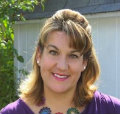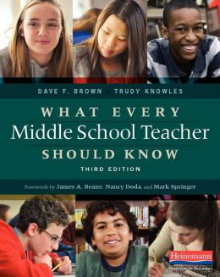A Middle School Classic Returns, Even Better
What Every Middle School Teacher Should Know, Third Ed.
By Dave F. Brown and Trudy Knowles
(Heinemann Publishing, 2014 – Learn more)

In even the best universities, teacher preparation programs can only go so far in educating pre-service educators on the realities of the classroom. Being immersed in the myriad day-to-day issues, pleasures and challenges of education creates an appreciation for what students bring with them to the classroom in a way no methods course can teach.

The place to start for newcomers
Chapter One is appropriately written to the person considering teaching middle school students. A combination of professional requirements and real commentary from inside the classroom, it invites readers to reflect on just how different middle school students are from their elementary and high school counterparts.
A close look at middle schoolers
Every middle school student faces growth spurts, hormonal changes, cognitive development, social interactions and emotional drama in such a relatively short time span that navigating daily life can be a challenge. Fortunately, in Part 2 of the text, all of these components of growth are addressed from the basis of both research and reality. From physical changes to the effects of technology to the role of family and development of an individual identity, what we see as a general age group of children with divergent needs slowly comes into focus as unique, complex students who grapple with their expanding world and their role in it.
The middle school model: why and how
In Part 3, the authors provide foundational, historical information on the creation and implementation of the junior high and middle school models, the role of scheduling and curriculum in today’s middle schools, and a refreshing reminder that middle school is built as much for learning to navigate the world as it is for developing content knowledge.
Down-to-earth ideas for building an invigorating learning environment
The five final chapters of the text, which comprise Part 4, focus directly on actions middle school teachers can take to make their classrooms more effective and engaging for students. More than fluffy theoretical exposition, these chapters share meaningful nuggets of advice that can be applied to your classroom, instruction and interactions with students as soon as you finish the reading.
The importance of creating a respectful, nurturing environment despite the wide (and sometimes wild) range of emotions each middle school learner embodies cannot be overemphasized and is an ongoing thread through all the chapters. And the authors frequently remind us of the necessity to include student input on as much of the curriculum, instruction and assessment as possible to maximize learning, retention and, ultimately, a meaningful educational process.
Before sending teachers off to begin implementing their suggestions, the authors share a short overview of how the meat of the text applies to the practicing classroom teacher. To avoid the shortcomings of other research-heavy texts, several points of consideration are given to help teachers get a better idea of how to implement the applicable parts of the text in their classrooms for immediate impact. New perspectives mean very little if the research doesn’t transform your teaching.
Fresh ideas for newbies and vets
When I left the high school classroom to teach middle school 14 years ago, my university coursework did little to prepare me for the reality of the challenges inherent to teaching middle schoolers. Other than a general psychology course and some lesson planning strategies, I received little tailored support, and it took a year until I felt I had solid footing. I honestly wish I’d had Brown and Knowles’ book to guide me in that first year. And even now, 20 years into my career, I’m grateful to have found this text. Even if you think you know all there is to know about this age group, you’re bound to understand the middle school mind differently after you finish reading What Every Middle School Teacher Should Know.
Beth Morrow is a freelance writer, blogger, veteran middle school ESL teacher and workshop presenter in Columbus, Ohio, who has been writing about education, health issues, and summer camp for over two decades. Her work has appeared in a variety of magazines, newspapers and blogs around the world. She provides educational and classroom resources at her blog, www.MorrowInTheMiddle.com, and tweets with educators @BethFMorrow.


































